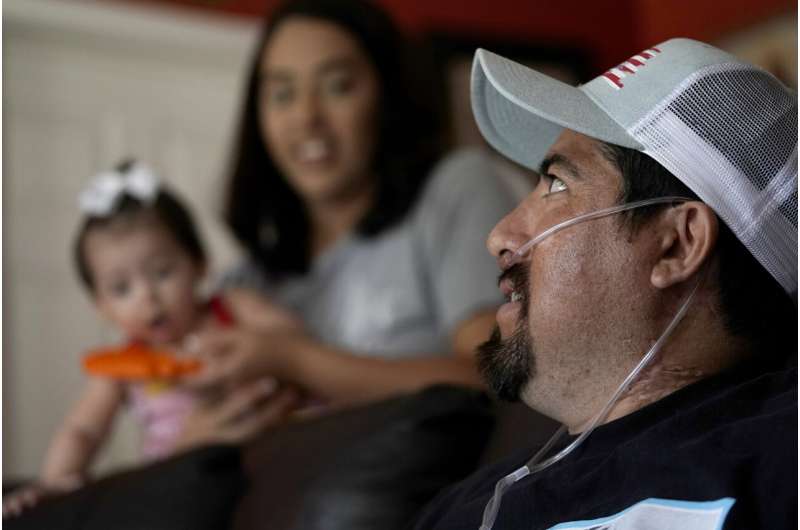
Freddy Fernandez almost wasn’t here, on his couch in his Missouri home, his baby on his lap, gnawing on the pulse oximeter that he uses to check his oxygen levels after a months-long bout with COVID-19.
Months after being warned that her partner might never hold his daughter, Vanessa smiles as the girl works to cut two teeth on the device that Freddy wears like a necklace, a blue ribbon tied around it.
Freddy spent five months hospitalized a four-hour drive away from the couple’s home in the southwest Missouri town of Carthage on the most intense life support available. The 41-year-old father of six nearly died repeatedly and now he—like so many who survived COVID-19 hospitalizations—has returned home changed.
While more than 1 million died from COVID in the U.S., many more survived ICU stays that have left them with anxiety, PTSD and a host of health issues. Research has shown that intensive therapy starting in the ICU can help, but it was often hard to provide as hospitals teemed with patients.
“There is a human cost that the patient pays for ICU survivorship,” says Dr. Vinaya Sermadevi, who helped care for Freddy throughout his stay at Mercy Hospital St. Louis. “It is almost like going to war and having the aftermath.”
Freddy’s memories from those long months come in snatches—moments where he regained consciousness, hooked up to machines to breathe for him, clinging to life. Sometimes he asked for his mother, who died of COVID-19 in September 2020.
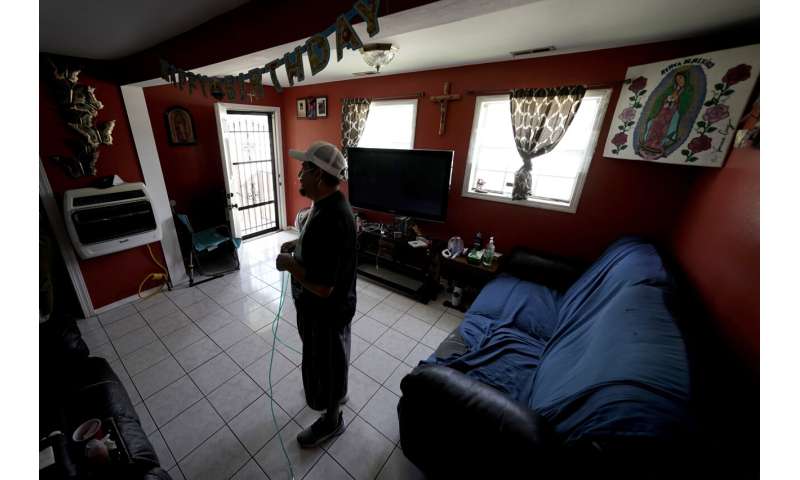
He missed the birth of his daughter, Mariana, and the first four months of her life. He may never be able to return to his construction job. His other young daughter is terrified he’ll go away again.
As the world moves on and mask mandates fall away, COVID-19 is not gone for them.
“We’re left with dealing with the leftovers of what it caused,” Vanessa says.
Vanessa, 28, was still pregnant with Mariana last summer when the delta variant struck poorly vaccinated southwest Missouri. She was skeptical about the vaccine, but her obstetrician reassured her it was safe and she decided to go ahead and get it.
Freddy was warming up to the idea, too. The native of Mexico City, had come to the U.S. around 20 years ago to work construction—cement jobs mostly—and was now a permanent resident. Sometimes he would work from 5 a.m. to 8 p.m., and often at least one day on the weekend.
On the very day in late August that they planned to schedule an appointment to be vaccinated, his throat began to ache. It was COVID.
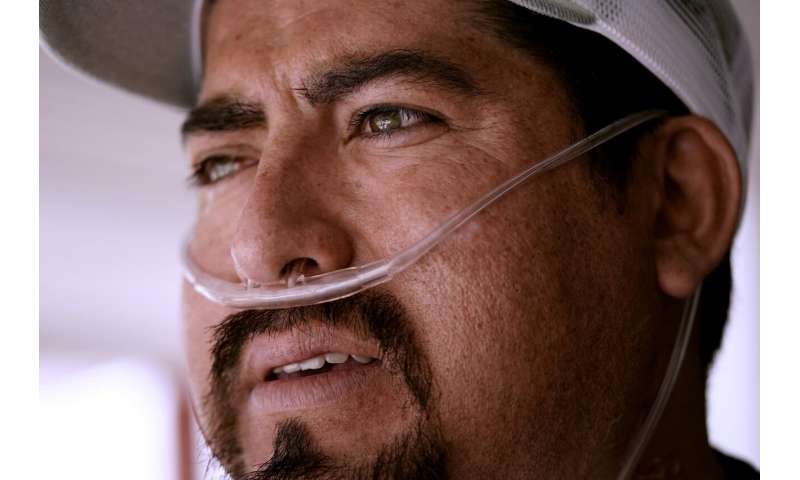
Days later, with Freddy coughing and struggling to breathe, Vanessa rushed him to the emergency room at the local community hospital. Freddy, although worried about his family, recalls thinking that “it’s only a little bit.”
But pneumonia was running through both of his lungs. The next day, he was taken to a larger Springfield hospital that was overflowing with patients and placed on a ventilator. That too wasn’t enough.
He wound up in St. Louis, nearly 270 miles away from his two younsg daughters; Vanessa’s 10-year-old son, Miguel, who considers Freddy his father; and three other children with his ex-wife—10-, 8- and 7-year-old boys.
It was a dark period when many people hoped the pandemic was ending, but the delta variant once again flooded the healthcare system. Filling shifts was a daily battle, and death was everywhere, recalls Dr. Sermadevi. She said that at the beginning of the pandemic, everyone was “stunned and astounded that this was even happening.” But grief, she says, has a “cumulative effect” and by the time the delta surge came “there wasn’t even room for those emotions.”
Freddy was lucky, though. For all the talk of ventilator capacity, what was in shortest supply during the delta surge was something called ECMO, or extracorporeal membrane oxygenation. It is used when a ventilator isn’t enough, pumping blood out of the body, oxygenating it, and then returning it.
Mercy Hospital St. Louis only had the equipment and staff to care for three ECMO patients at a time. And on Sept. 3, Freddy became one of them.
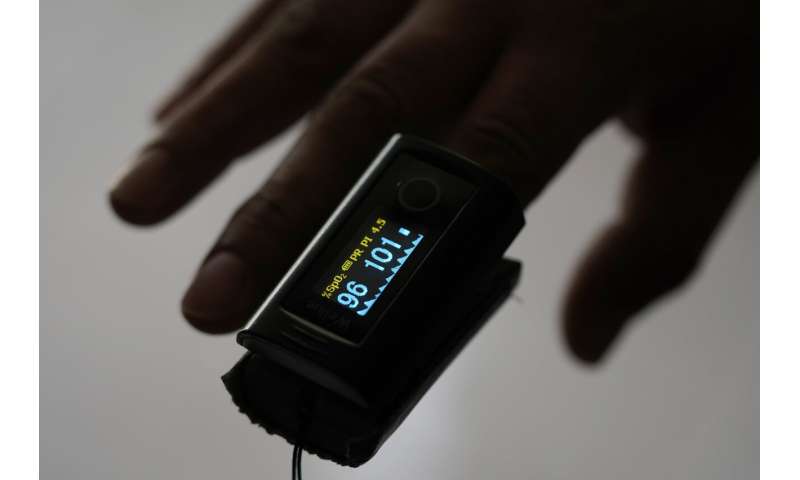
There were risks, though, to the long hospital stay he was embarking upon, says Dr. Ann Parker, a pulmonologist who co-directs the Post-Acute COVID-19 Team clinic at the Johns Hopkins University School of Medicine.
Survival rates for ECMO patients slipped during the pandemic to around 50%, according to a 2021 report by the medical journal The Lancet.
That meant even being on the machine, his chances at surviving were far from guaranteed.
Vanessa delivered Mariana on Oct 13. Freddy had been in the hospital for 48 days, and he didn’t even know he was the father of a healthy, 6-pound, 11-ounce daughter.
Far away from her fiancé, Vanessa logged into video calls with Freddy’s doctors the same day she brought the newborn home. The news wasn’t good—Freddy was suffering from infections and wasn’t recovering well.
A lung transplant, Sermadevi said, appeared to be his best option, but was a long shot, she warned them.
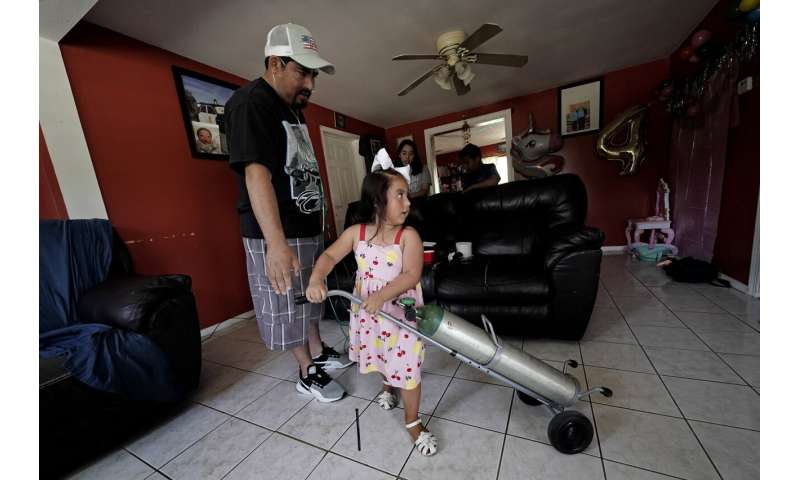
“I don’t want to give you false hope,” Sermadevi recalls telling the family. “And there is a chance that Mariana might grow up without a father.”
Vanessa, helping the hospital interpreter translate for Freddy’s family, glanced at the baby snuggled on a bouncy chair by her side. She was wearing the same hand knitted yellow and white sweater and booties that the couple’s oldest daughter, now 4-year-old Melanii, had also worn home from the hospital.
She wanted to keep fighting.
So when the baby was just a week old, Vanessa began making the weekly drive from Carthage to St. Louis, where she stayed in a hotel from Mondays through Fridays. Freddy’s sister joined her, and her parents watched the children. It meant giving up the early months with the newborn.
“I have to split myself into two,” Vanessa remembers deciding. “I knew she needed me, but he also needed me. And so I knew that if I was there with him, there is a chance for him to come home and then we would all be able to be home with her. So I had to take that risk.”
Some of the most important keys to recovery in critical care aren’t medical. Visits from relatives, along with physical, occupational and speech therapists, have long been shown to be a difference maker for the sickest of patients.
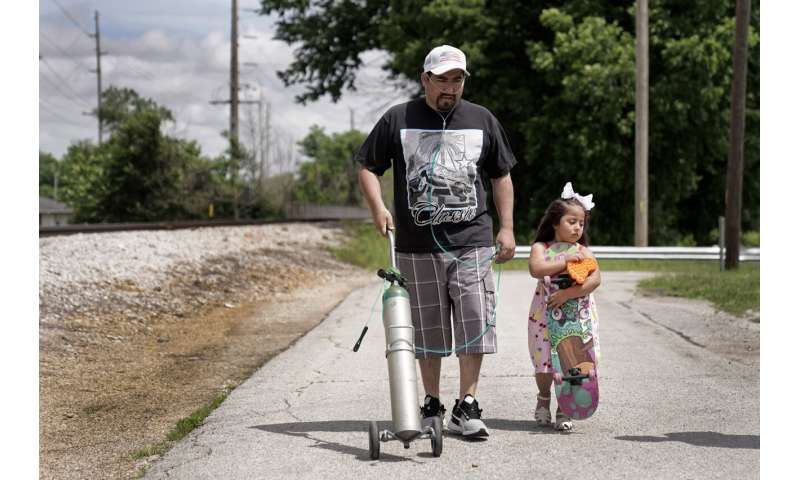
COVID-19 upended those practices at many hospitals, as families were kept away to keep the virus from spreading.
“When our health care system starts to get overwhelmed and our hospitals start to get overwhelmed, some of those things are not prioritized as much as we would like them to be,” Parker says. “And this impacts patient care and patient outcomes.”
Fears of infection, plus short staffing, also often meant less physical therapy, proven to speed recovery.
When Freddy’s family came, it made all the difference.
His room was transformed, photos of his family thumbtacked to the ceiling. Freddy’s family held his hand when he had respiratory distress, talking him through it. He needed less sedation and pain medication because, she says, “they were that for him.”
“We would just hear such love at the bedside,” she says. “And I feel like there’s only so much you can do in medicine, and then there is the rest.”
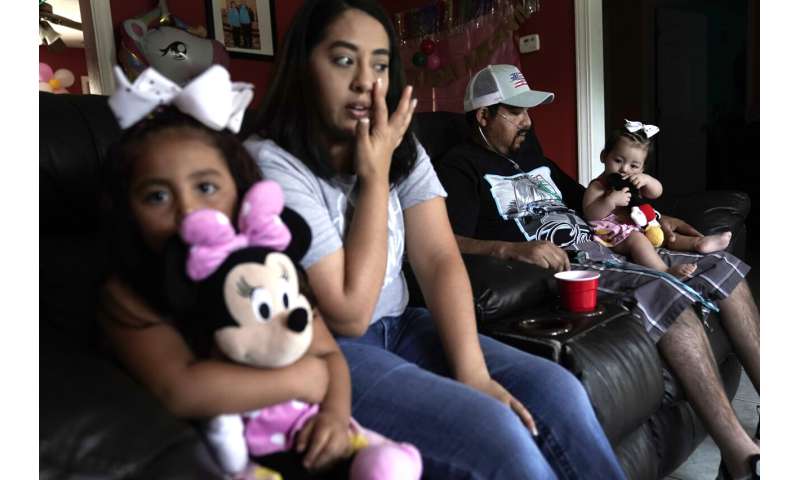
Money grew tight, though, with both Freddy and Vanessa no longer working. People showed up on the family’s doorstep. “Here,” they told her, “we know you need it.” A devout Catholic, she prayed sometimes 10 times a day, begging God, “Please, give them a miracle; heal him. He has all these kids he has to watch grow up.”
As the weeks wore on, staying on the ECMO was becoming unsustainable. There was bleeding and infections.
What followed was a careful dance that involved weaning down the ECMO settings and increasing the ventilator settings to get his lungs to do more of the work.
Dec. 2 was the day he came off the machine, and Vanessa was warned there were no guarantees that it would be a success.
“But in my mind and in my heart, I guess spiritually, I didn’t have that mentality,” Vanessa says. “I had the mentality that he was going to make it.”
That first night was fitful. After he made it through, his sister embraced the doctors. He had a chance.
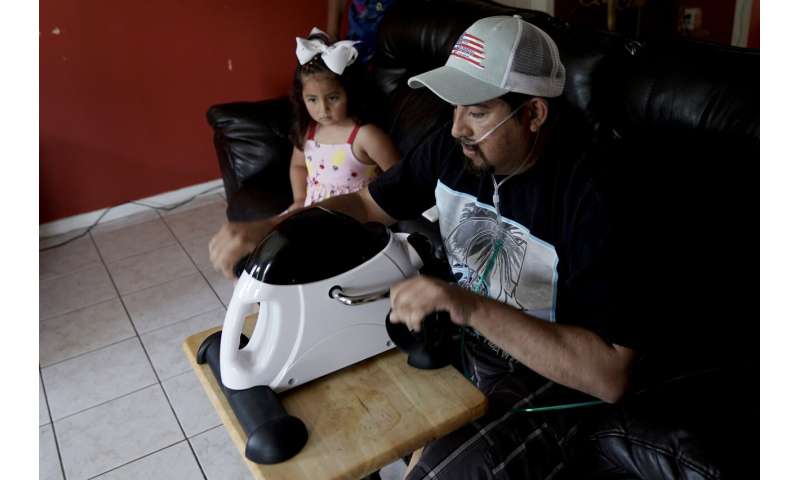
With his lungs slowly improving, soon Freddy was up and trying to walk. Three people helped as he took his first steps on legs that were so numb just a few weeks earlier that he asked a cousin whether he still had them. The staff was overjoyed—a manager pulled out pom-poms, and there were streamers.
Ultimately, lung transplant talk was tabled.
By Feb. 9, he was heading home, 167 days after he first arrived at the hospital in his hometown.
Outside, the glass door of Freddy’s room, the nurses had drawn two lungs, coloring them blue and red. Next to the lungs, they wrote “We’ll be the-air for you.”
All Vanessa could think was “finally.” Freddy had never met his baby. Nor had he seen any of his other children. Their interactions had been limited to Facetime and pictures.
Freddy arrives home. Melanii is shy, hugging him briefly along with older brother Miguel, before clinging to her mother.
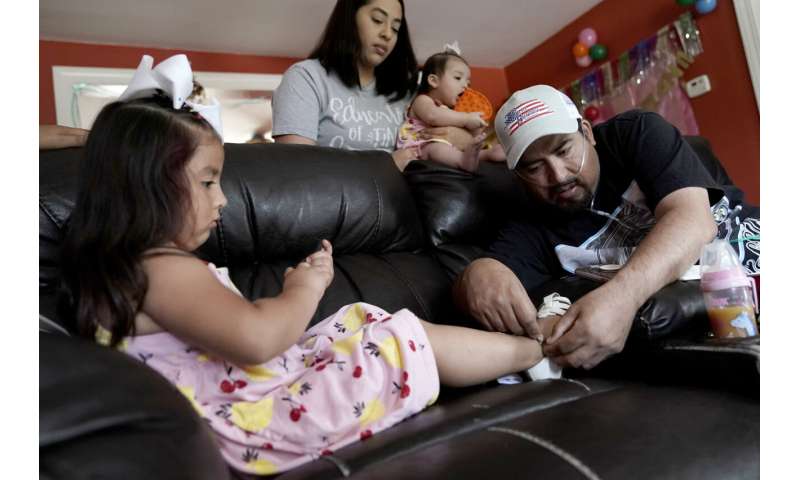
“I told you daddy was going to come home, right?” Vanessa tells a smiling Melanii before pulling the baby from the car seat.
“Can your daddy hold your sister?”
Vanessa kisses the baby and then lays him in Freddy’s arms. Now just days away from turning 4 months old, Mariana smiles at him.
Melanii had been his shadow before the pandemic, “Daddy’s Princess,” following him around the house and outside as he cleaned his truck. In the months that he was gone, she consoled herself by watching a video of her parents dancing to Latin country music. Her father spins her mother around; both are smiling.
Now, she is still afraid, Vanessa says, “because every time he has an appointment, she’ll say, ‘Don’t go.’ She doesn’t cry. She just says, ‘Don’t go.”
Freddy relied on a walker and a wheelchair at first. He couldn’t sit or eat on his own.
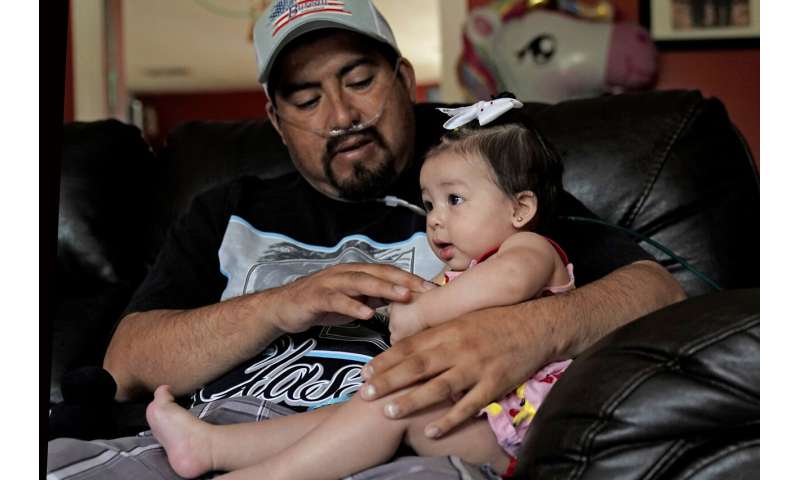
But now the wheelchair is abandoned on the home’s back steps. He walks around the entire block, pulling a portable oxygen canister behind him on a dolly. He’s on the cusp of being able to carry his oxygen around in a backpack, which would give him more freedom.
The family spends hours outside in the late afternoon and evening, Freddy watching the children jump on the trampoline. His German Shepard sticks by his side.
“At the beginning he would be anxious,” Vanessa says. “Now I think with him seeing his own change progressing, I notice he’s been doing a lot better. I think he’s more upbeat than anybody right now. He’ll have his moments where he’s like, ‘Oh, I feel good.'”
Vanessa is returning to work, life returning “back to normal a little bit.”
They want to wait until Freddy gets better to get married.
Yet they don’t know how much better he will get—or how quickly.
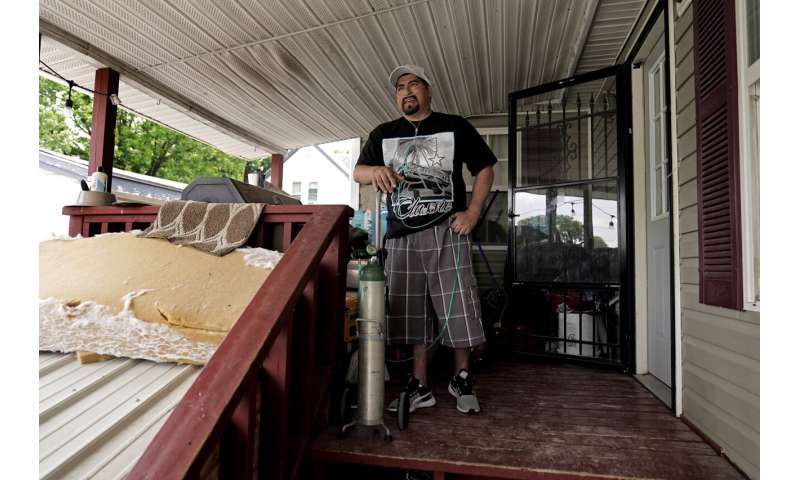
Such is the story of so many, who are alive yet forever changed, says Sermadevi, who has followed his progress from afar. Some of the nurses even became Facebook friends with Vanessa.
“It’s sad and happy at the same time,” she acknowledges. “And that’s very hard to reconcile.”
HEATHER HOLLINGSWORTH

